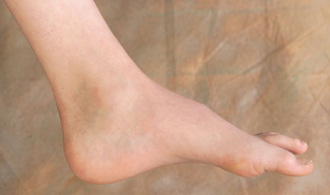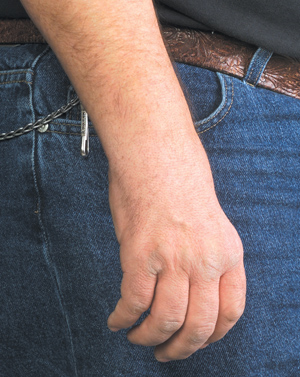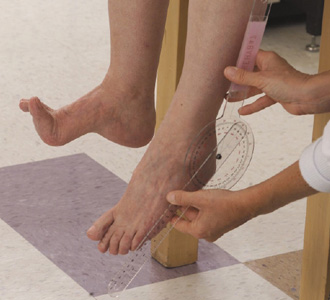Charcot-Marie-Tooth Disease (CMT)
Signs and Symptoms
Partly because there are different types of Charcot-Marie-Tooth disease (CMT), the exact symptoms vary greatly from person to person. This section presents a general picture of CMT signs and symptoms.
 Contractures and bone deformities
Contractures and bone deformities
The most common initial presentation of CMT is distal weakness and atrophy, which manifest with foot drop and pes cavus (high arched feet).
Many patients with CMT eventually develop contractures (stiffened joints) that result in deformities of the feet and hands. The contractures occur because as some muscles around a joint weaken, others remain strong, contracting and pulling on the joint. Over time, the bones around the joint shift into abnormal positions.
For example, as muscles that lift the foot at the ankle become weak, muscles that lower and curl the foot downward contract and tighten, causing the most common type of foot deformity — a shortened foot with a pes cavus. As the contracture gets worse, the toes can become locked in a flexed position.
A small fraction of people with CMT develop “flat feet” (pes planus), presumably because of a different pattern of muscle weakness.
During walking, these deformities can cause unusual friction against the toes, heel, and ball of the foot, leading to painful abrasions, blisters, and calluses. If left untreated, the contractures and secondary abrasions tend to worsen over time, making walking increasingly difficult.
 As CMT progresses, contractures in the hand can lock the fingers in a flexed position, and in rare cases, severe proximal weakness can lead to scoliosis (side-to-side curvature of the spine) or kyphosis (front-to-back spine curvature).
As CMT progresses, contractures in the hand can lock the fingers in a flexed position, and in rare cases, severe proximal weakness can lead to scoliosis (side-to-side curvature of the spine) or kyphosis (front-to-back spine curvature).
A small fraction of people with severe CMT also experience hip displacement at an early age.
Muscle weakness
In general, people with CMT experience slowly progressive weakness and wasting in the distal muscles, the muscles furthest from the center of the body.
The muscles that control the feet, lower part of the legs, forearms, and hands are most affected.
Usually, weakness begins in the feet and ankles and manifests itself as foot drop — difficulty lifting the foot at the ankle, so that the toes point downward during walking.
Foot drop causes frequent tripping, and with increasing weakness and attempts at compensation, the affected person develops an abnormal gait.
Although usually too slight to cause disability or discomfort, some people with CMT experience tremor.
Sensory loss
Because CMT causes damage to sensory nerve fibers (axons), people with CMT can feel tingling and burning sensations in the hands and feet, usually causing only mild discomfort but sometimes causing pain. The sense of touch is diminished, as is the ability to sense changes in temperature.
 Even though they may have sensory loss, many people with CMT experience cold hands and feet, which may be related to loss of insulating muscle in these areas.
Even though they may have sensory loss, many people with CMT experience cold hands and feet, which may be related to loss of insulating muscle in these areas.
People may sustain injuries to the hands and feet without realizing it, so it’s important to check extremities regularly for such injuries to avoid infection.
In many people with CMT, sensory loss is associated with dry skin and hair loss in the affected area. In rare cases, sensory loss can include gradual hearing impairment and sometimes deafness

